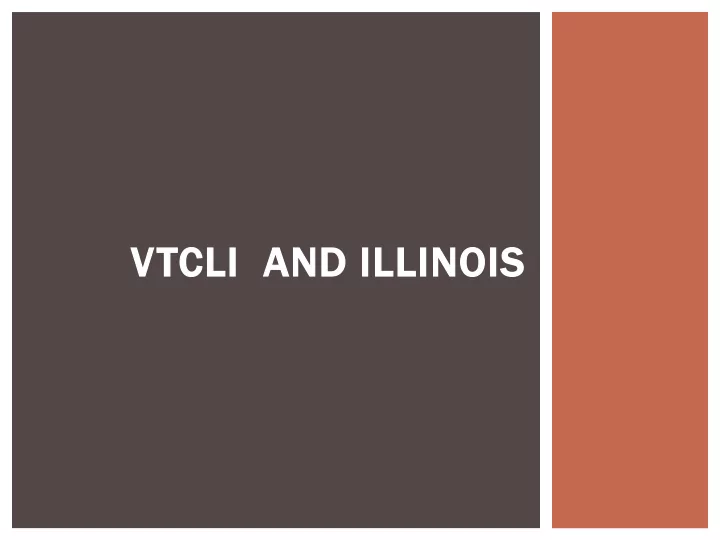

VTCLI AND ILLINOIS
ILLINOIS VETERANS
Veteran Population
SOCIO-ECONOMIC DATA • Illinois and HSTP snapshot Populat ation Veter eran ans Percent cent Vet Illinois 5,964,460 284,698 4.7% HSTP 8 184,223 11,014 5.9% Illinois Veterans HSTP 8 HSTP 8 Veterans 65 and older 13.5% 38% 12.7% 21% Disabled 10% 18% 9% 14% Median Income $48,479 $31,045 $45,088 $38,529 Bachelors Degree 22.5% 32.2% -- -- -- -- Below Povery Line 16.6% 5.5% 15% 1% Source- 2008-2012 ACS Aggregate data
SOCIO-ECONOMIC DATA • Age cohorts important as well • WWII, Korean War, Vietnam vets aging • Baby boomer demand increase for specialized transportation GWOT Vets returning with more severe disabilities • • More demand for specialized transportation Age cohorts Illinois HSTP 8 Totals 284,698 11,014 Veterans Ages 18-34 7.8% 12.8% Veterans Ages 35-54 21.8% 23.5% Veterans Ages 55-64 22.8% 22.5% Veterans Ages 65-74 20.5% 17.8% Veterans Ages 75+ 26.9% 23.3% Source- 2008-2012 ACS Aggregate data
EXISTING SYSTEMS AND SERVICES
VETERANS INTEGRATED SERVICE NETWORK (VISN) Geographical area defined by VA Used by both VA (disability claims, mortgages) and VHA Issues of states boundaries -4 VISNs intersect in in Illinois, all 4 extend outside Illinois availability of services -While availability of services is generally good in individual VISNs. Occasionally veterans have to travel outside their VISNs to find appropriate care need to access other VISN services -Specialty services may not be available in all VISN. -If they are, patients may have to travel hundreds of miles to get to them - ”Veterans Choice” initiative proving problematic
VISN and VA Medical Facilities
VETERANS TRANSPORTATION SYSTEM (VTS) Designed to provide Veterans and family members with reliable, free transportation for non emergency medical care - Internal VA system - Occasional leasing of equipment to VACs Limited, imperfect rural veterans transport available in Illinois
VTS
COUNTY LEVEL VETERANS ASSISTANCE COMMISSIONS (VAC) What it is? - A County government entity designed to serve veterans who are residents within a county area. Who forms it? - Two or more Veterans Service Organizations within one county What does it do? - Aids veterans with financial assistance, VA disability claims, transportation vouchers, and in some cases directly provides transportation to VA facilities. How is it funded? - Usually funded by County Tax levy. - Direct transportation a notable exception.
Veterans’ Assistance Commissions
VETERANS SERVICE OFFICERS (VSO) Federal Veterans Administration -VSOs working at federal level available at most VA facilities -VSOs actually employed by VA grants to DAV, VFW, American legion Illinois Veterans Administration -Illinois VA employs its own VSOs, independent of veterans service organizations. Offices/Meetings -Often on a biweekly or monthly schedule -Meetings in county offices, NG armories, public libraries
IL DEPT. OF VETERANS AFFAIRS VSO MEETINGS Very Comprehensive VSO meeting place map Put together by IL VA Includes VSOs working at federal level No transportation, only help with VA claims
INFORMATION ON SERVICES VISN: Information on Medical Centers A list of centers and contact information by state can be found online on the Veterans Administration website. VTS: Information on Transportation Services Information on transportation services is available only at the service point. VAC: Service Information Only a few of the 45 VACs have their own websites. Information may be found on a County website or on the IAVAC website. These do not mention transportation available to veterans. VSO: Information on Meeting Locations A website sponsored by the Illinois VA lists the scheduled meetings and offices by County.
SUMMATION OF PROBLEMS VISN Issues 4 intersect in Illinois Splitting of HSTP regions Geographical area VTS Issues Limited, imperfect rural veterans transport available in Illinois Seemingly arbitrary and inconvenient pickup spots Information on services is difficult to find. VAC Issues Massive variance of service. Only 15 VACs offer transportation services. VSO Issues Very limited amount of vouchers to be handed out Bi-monthly, or even monthly meetings
THE VTCLI
VTCLI GRANT The Veterans Transportation and Community Living Initiative (VTCLI) is an innovative, federally coordinated partnership that will make it easier for U.S. veterans, active service members, military families, and others to learn about and arrange for locally available transportation services that connect them with work, education, health care, and other vital services in their communities. Drawing on existing federal resources, and in consultation with advocates for veterans and people with disabilities, projects are being funded in urban, suburban, and rural communities around the nation to strengthen and promote "one-call" information centers and other tools that conveniently "connect the dots" as never before. These deserving men and women and their families may quickly and conveniently turn to trusted sources who have been specially trained to help them access local transportation options and other support services, ranging from workforce training to food pantry locations. Source- FTA Website
HOW THE VTCLI WILL HELP Most VTCLI grants implement a one-call/one click center as a regional project to create an integrated booking and dispatching system. This allows users to connect to multiple transportation services with a single call or a single visit to a website. Lee County has this type of regional grant. The Urban Transportation Center received a grant to create a “one - click” website to provide information on multiple services such as public transit, veterans transportation services, senior transportation and inter-city transportation.
NEEDS ASSESSMENT Methodology A formal, semi-structured, telephonic interview with three groups of participants Participants HSTP Coordinators, Public Transportation Providers, and County level VACs Structured Interviews Three developed, one specifically for each group of participants. Results Differences in perspective on the level of information available for veterans and their families in accessing existing transportation system. Illuminated view on gaps in existing systems
CONCLUSIONS Veterans have higher rates of disability than the general population. Higher senior cohort than general population Younger disabled veterans may be more severely disabled due to the higher survival rates for sever injuries.
Recommend
More recommend